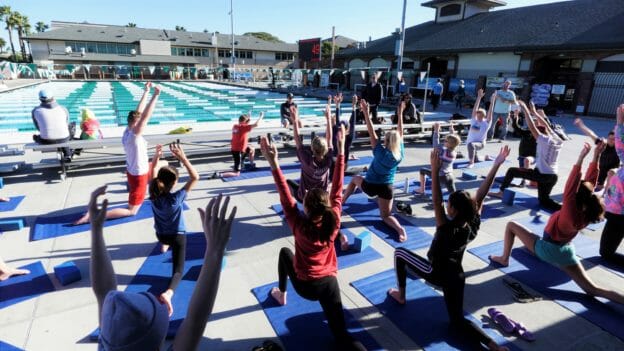Why you should stretch your shoulders before a workout
Swimming is a low-impact sport, causing few severe traumatic injuries when compared to contact sports. That is not to say that Swimming is devoid of injuries. It isn’t. Swimmer’s Shoulder is the most common injury found in Swimming and has an incidence among competitive swimmers that have been reported anywhere from 30% to 90%, depending on the study and the age of the swimmers studied. In all of the studies of Swimmer’s Shoulder that I have seen, the incidence seems to be significantly high. The question is: Can we do something to reduce the incidence and severity of Swimmer’s Shoulder?
Most of the shoulder injuries in Swimming can be attributed to overuse – lots of meters of swimming strokes. According to Dr. Pieter Homman, an Orthopedic Sports Medicine specialist in Miami, Florida, and former competitive swimmer, most shoulder-related swimming injuries he sees in his practice are of two types- tendonitis and impingement injuries. The most common tendonitis problems occur in the Biceps and Supraspinatus tendons. The impingement injuries often result in small tears in the rotator cuff formed by the tendinous insertions of the Supraspinatus, Infraspinatus, Subscapularis, and Teres Minor muscles or in the labrum, a fibrocartilaginous tissue holding the arm in place. Sprinters can also develop shoulder injuries, even with less training distance, as they place a tremendous amount of torque on the shoulder joint.
Aside from mostly being attributed to overuse or swimming lots of miles, there are two other important contributing factors to developing Swimmer’s Shoulder. One factor is the anatomy of the swimmer’s shoulder girdle, including the scapula, clavicle, and humerus bones and joints. The shoulder girdle is a complex and highly variable anatomical structure. Seventeen different muscles insert into the scapula bone. Swimming is an overhead sport meaning that it requires that the shoulder reach complete abduction, fully extended overhead. About half of that motion is attributed to the upper arm moving in the joint, and the other half is attributed to the rotating scapula. Having scapular mobility is an essential factor in achieving the ideal Swimming and streamlining biomechanics. Any overhead sport (Swimming, Baseball, Tennis, etc.) will put the shoulder at a higher risk of injury. In addition to requiring complete abduction and adduction, the ideal swimming stroke cycle also includes considerable ranges of motion of the shoulder in nearly every aspect, including internal rotation, external rotation, extension, flexion, and scapular elevation, tilt, and rotation.
The third factor contributing to Swimmer’s Shoulder is the swimmer’s biomechanics – the precise motion of the arm and hand during the pulling cycle and recovery. Being a technique coach, I see extremely variable motions of the arms throughout the freestyle stroke cycle. Some swimmers pull deeply. Others use a high-elbow pull (early vertical forearm). Some in sweep or out sweep with their hands during the pull, while others pull in a straighter path backward. Some recover their arms widely over the surface, while others recover with the arms more vertically. Some bend the elbows on the recovery, while others recover with more of a straight arm. How do all of these variable motions impact the likelihood of developing Swimmer’s Shoulder? I wish we knew more.
Of one thing, I am certain. During the pulling motion (underwater), there is much more torque on the shoulder than during the recovery. That is not to say that impingement doesn’t occur during the swimmer’s arm recovery, but the forces or loads are more significant on the shoulder when the hand is underwater. There are significant biomechanical differences between the deeper pulling motion of a sprinter, for example, and the high-elbow pull of a distance swimmer. I have observed that the deeper or in-sweeping pulling motion is more likely to cause Bicipital tendonitis.
In contrast, the high-elbow pulling motion increases the risk of developing Suprispinatus tendonitis. Either form of tendinitis can become debilitating if not treated early and appropriately. The hope is to prevent Swimmer’s Shoulder from happening, or, if it does occur, resolve it before the tendonitis becomes severe or chronic.
The appropriate treatment of Swimmer’s Shoulder is beyond the scope of this article, but three important methods of prevention are worth mentioning. First, be careful and mindful of the amount of distance a swimmer trains and the age at which a swimmer increases the training load. Swimming more distance puts swimmers at higher risk of a shoulder injury, especially when the muscles and tendons are not fully developed. Be judicious in the use of hand paddles, which can add considerably more load or torque affecting the shoulder joint.
Second, be mindful of the biomechanics of the swimmer’s arm cycle. Where in the cycle does the shoulder pain occur? Under water or during the recovery? Why is it occurring there? Changing the swimmer’s biomechanics or technique may help reduce the risk of a shoulder injury.
Third, swimmers should do some important shoulder stretches before practice. While the benefit of pre-workout stretching in non-ballistic movement sports like swimming is controversial, most experts feel that chronic stretching to improve flexibility will help reduce the chance of injury in these sports. Dynamic stretching of shoulder muscles and tendons before workout will also increase the blood flow to these areas.
This week in our Race Club video, we highlight six of our favorite pre-workout shoulder stretches to help keep your shoulders healthy and pain-free. We hope that you will consider using them before your workouts.
Yours in Swimming,
Gary Sr.

